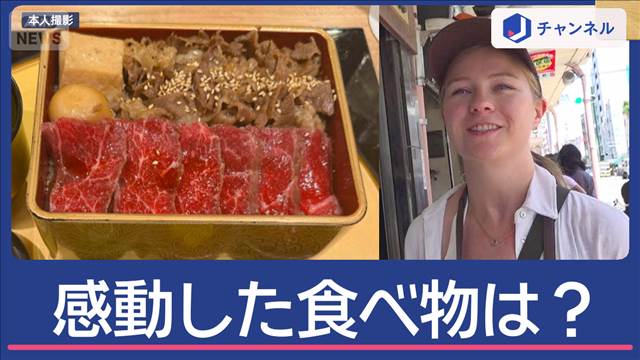Rediscovering Japan’s charm through the eyes of foreign tourists. We asked them about the most impressive food they tried in Japan. At the popular “Kappabashi Dougu Street,” we asked, “What was the most memorable food you had in Japan?” A couple from Denmark shared their experience…
Bertram from Denmark: “I went to a Wagyu beef restaurant. There was a mountain of rice topped with thinly sliced Wagyu beef.” What impressed Bertram the most was the “Roast Beef Bowl” he had in Akihabara.
Bertram: “It was incredibly delicious. The meat was so tender.” When we filmed the roast beef bowl that the Danish man praised, we noticed the chef’s dedication to achieving perfect tenderness. The presentation, with the meat piled high like a mountain, was inspired by the image of Mount Fuji glowing red at sunrise—known as “Red Fuji.”
From the U.S.: “Wow! So good!” Foreign visitors love it. The dish uses A4-grade or higher Kuroge Wagyu beef, slow-cooked at low temperature for 8 hours, then refrigerated for 12 hours before a final sear. This process concentrates the Wagyu’s sweet fat and juices into the roast beef.
Bertram: “There’s an egg on top and onion sauce around it. You poke the egg, let it drip down, pick up the Wagyu from the side, dip it in the sauce, and eat it. The tenderness is outstanding—you can feel it melt in your mouth. You should try it. I even recommended it to some Japanese people.”
Andrea from Denmark was amazed by the “melon bread” and “strawberry candy” she tried in Asakusa’s Nakamise Street.
Andrea: “The melon bread had vanilla ice cream inside, and I ate it with strawberry candy. It’s perfect for a hot day.”
Foreign visitors to Japan exceeded 20 million in the first half of this year, setting a new record. Tourists from all over the world flock to Japan for its delicious food.
Colin, a cheerful visitor from the French Caribbean island of Saint Barthélemy, shared his thoughts.
Colin from Saint Barthélemy: “(Q: Best food in Japan?) Nigiri. I LOVE nigiri.” “(Q: What kind of fish?) Tuna, fatty tuna.” “Fatty tuna” refers to well-marbled tuna, though curiously, the photos he showed were mostly of salmon. Why so little tuna?
Colin: “I eat the tuna too quickly to take pictures. I devoured 20 pieces in no time. This is tamagoyaki (egg omelet), and baby egg too. The chef saw me, my wife, and our child, so he made larger pieces for us and smaller ones for our kid.”
Colin finds happiness in Japanese sushi. When asked what draws him to it…
Colin: “The freshness is different.” He answers in Japanese: “Shinsen (fresh).” “The rice preparation is different, and the fish is incredibly tasty. France and Europe have special restaurants too, but in Japan, almost every place is exceptionally good.”
A first-time visitor from the U.S. was thrilled by…
First-time visitor from the U.S.: “Last night, I had omurice and Wagyu cutlet. Unbelievably fantastic!” He highly praises the “omurice” and “Wagyu cutlet” he had in Shibuya.
Fluffy omelet with plenty of butter, served with tomato sauce and fresh tomato chicken rice. A luxurious omurice paired with rare-cooked Wagyu cutlet.
First-time visitor from the U.S.: “It was rich, fatty, and so comforting. The restaurant had a friendly atmosphere too. I’d absolutely recommend it. I haven’t sent the photos yet, but when I do, I’m sure they’ll get a huge reaction.”
A couple from the Netherlands is also obsessed with Wagyu. Their most memorable food in Japan was a premium “Wagyu bowl” they had in Osaka.
From the Netherlands: “It was so delicious. The meat melted in my mouth. We have Wagyu in the Netherlands too, but it’s very expensive. In Japan, it’s affordable.”
An Indian woman was impressed by the “yakitori” she had in Kyoto.
The Japanese term “yakitori






